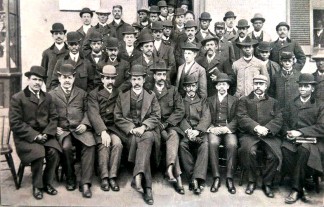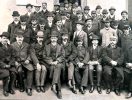
Members of African American YMCA, Representatives of the YMCA, undated, National Board of Young Men’s Christian Association Armed Services Dept., Kautz Family YMCA Archives.
Digitized materials, dating from the 16th century to present, will include nearly half a million pages of print documents, images, and audio and video recordings from across more than 70 collections within the Libraries’ Archives and Special Collections Department.
As materials are digitized – an effort led by the University’s Givens Collection of African American Literature – they will be made publicly available via online search tools, such as the U of M Libraries website, Digital Public Library of America, and Umbra: Search African American History (umbrasearch.org). Umbra, created by a separate Libraries project, is a search tool that brings together digitized materials representing African American history and culture from libraries and archives across the United States.
‘There is no American history without African American history’
“By identifying and making discoverable online the impact of African Americans in every aspect of American life, this project makes an argument about history and how we tell it,” said Cecily Marcus, co-principal investigator of the CLIR grant, Givens Collection curator, and head of the U of M’s Umbra project. “The significant presence of materials documenting African American life from over 70 collections shows us that there is no American history without African American history. Easier access to more materials means a richer, more holistic story can be told and understood.”
Within the University of Minnesota’s Archives and Special Collections, the issue of race and community can be seen as one central theme when looking through the vast materials housed in its separate but related collections.
Examples include:
- The formation of historically Black YMCA centers and the role of Settlement Houses in African American neighborhoods
- The experiences of African American soldiers in World War I
- 16th and 17th century maps documenting the African slave trade
- How African American student groups shaped the priorities of a university
- The papers of noted African American artists, writers, and professionals, such as Jacob Lawrence, Andrea Davis Pinkney, and St. Paul architect Cap Wigington, among others.
“At a time when the widening divide between shrinking institutional resources and expanding technological capacities has become more acute, the Umbra African American Digital Collection offers a unique model for building the presence of under-represented texts and contexts in local and national digital libraries,” said University of Minnesota Professor, John S. Wright, Ph.D.
About CLIR and the Digitizing Hidden Special Collections program
The U of M project is one of 18 funded by CLIR as part of its 2015 Digitizing Hidden Special Collections and Archives program.
CLIR is an independent, nonprofit organization that forges strategies to enhance research, teaching, and learning environments in collaboration with libraries, cultural institutions, and communities of higher learning. Its Digitizing Hidden Special Collections and Archives program is a national competition that awards up to $4 million for digitizing collections of rare and unique content and is funded by the Andrew W. Mellon Foundation.





